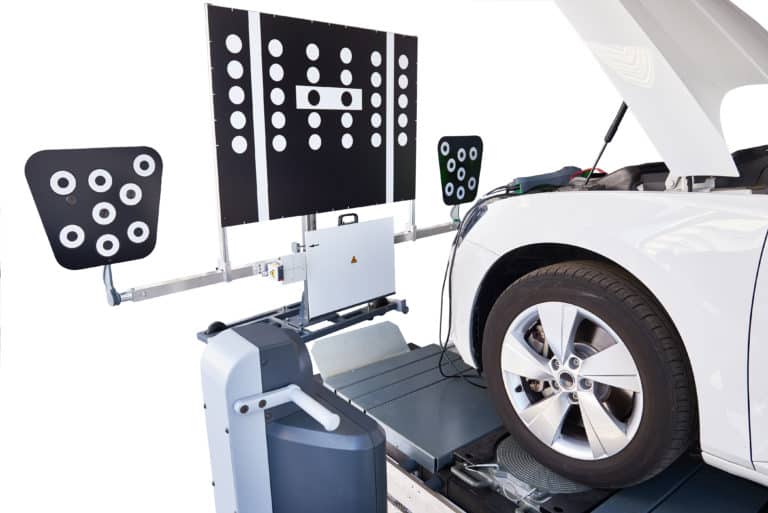With every new car model, the buzz around Advanced Driver Assistance Systems (ADAS) seems to grow louder. Yet, terms like Passive and Active ADAS can sometimes be confusing among the rest of the information coming out. Whether you’re exploring options for your next car or want to understand the tech behind the wheel, this guide will shed light on passive safety features and ADAS systems, what they are used for, and explain how they make our roads safer.
What is a Passive ADAS System?
Passive ADAS systems use sensors and systems to notify the driver of potential hazards. Unlike their active counterpart, passive safety features do not operate the vehicle; it is up to the driver to use the alerts and perform the correct maneuver. These systems are especially useful in protecting passengers against collisions, accidents, and other road hazards by providing real-time alerts and warnings.
Some of the common alert mechanisms include audible alarms, blinking indicators, and occasionally haptic feedback like a vibrating steering wheel notifying the driver of a potential collision. An undistracted driver can use these alerts and warnings to navigate the roads better and avoid accidents.
As these systems continue to evolve, they will become more and more sophisticated, making the roads safer.
Advantages of Passive ADAS
Passive ADAS systems are beneficial in many scenarios due to their ability to provide timely alerts and warnings. For example, they can detect and alert drivers about vehicles in their blind spots, potentially averting serious accidents. They are also helpful in some conditions of reduced visibility, where they can warn the driver of obstacles or road conditions that might not be easily visible.
Another benefit of passive ADAS systems is their ability to collect data and provide insights into driving patterns. This data can be used to analyze and improve vehicle design, road infrastructure, and driving behavior. This information can also help identify areas requiring additional safety measures, leading to reduced accidents.
Limitations of Passive Safety Feature Systems
However, these safety features have limitations. They serve solely as alert systems and do not take active control of the vehicle to prevent an accident. In other words, they rely on the driver’s reaction to the alert. If the driver is unable to respond promptly or appropriately to warnings, the passive system’s effectiveness is reduced. Additionally, these systems may also produce false alerts due to technical glitches or environmental factors, which could lead to drivers ignoring these alerts over time. That being said, drivers should be aware of how accurate the ADAS systems are in their vehicles; the SAE is a great resource for this.
Also, passive ADAS systems are not foolproof and may fail to detect certain types of hazards or objects in certain conditions. For instance, they may not be effective in extreme weather conditions like heavy snowfall or during nighttime when visibility is limited.
While passive systems play a crucial role in enhancing road safety, it is important to be aware of their limitations.
Key Examples of Passive Safety Features
Passive ADAS systems come in various forms and are often packaged together with other safety features. Here are some common examples of passive ADAS features found in modern vehicles:
Forward Collision Warning (FCW):
Function: Monitors the road ahead and uses sensors (like cameras, radar, or lidar) to detect if the vehicle is approaching another vehicle or obstacle too quickly.
Lane Departure Warning (LDW):
Function: Monitors the vehicle’s position within its lane using cameras. If the vehicle starts to drift out of its lane without a turn signal activated, the system alerts the driver.
Blind Spot Monitoring (BSM):
Function: Uses radar or ultrasonic sensors to monitor areas that may not be easily visible in the driver’s side and rearview mirrors.
Rear Cross Traffic Alert (RCTA):
Function: Monitors the area behind the vehicle while in reverse.
Driver Attention Warning (DAW):
Function: Uses cameras and sensors to monitor the driver’s face and eyes for signs of drowsiness or distraction.
Traffic Sign Recognition (TSR):
Function: Uses cameras to identify and read road signs, such as speed limits, stop signs, and no-entry signs.
These are just a few examples of the numerous passive safety features in existence today. While these systems may vary in implementation and functionality, their primary goal is to provide helpful alerts to the driver. Below, we will explain how each system helps the driver be safer.
How do Passive Safety Features Increase Driver Safety?
Now that you are aware of how some of these systems function, here is how they help with driver safety.
Forward Collision Warning (FCW):
Safety Benefit: Alerts the driver with visual and/or auditory signals, allowing them to take preventive action, like braking or steering away.
Lane Departure Warning (LDW):
Safety Benefit: Helps prevent unintended lane departures, which can lead to accidents.
Blind Spot Detection (BSD):
Safety Benefit: Notifies the driver with visual and/or auditory alerts if there’s a vehicle in their blind spot, especially useful when changing lanes.
Rear Cross Traffic Alert (RCTA):
Safety Benefit: Alerts the driver if a vehicle is approaching the back of the vehicle; this is very useful for backing out of parking lots.
Driver Monitoring System (DMS):
Safety Benefit: If the system detects that the driver is not paying attention or is getting drowsy, it sends an alert, prompting the driver to take a break or refocus on the road.
Traffic Sign Recognition (TSR):
Safety Benefit: The system displays the recognized traffic sign information on the vehicle’s dashboard or head-up display. This assists drivers by reminding them of current road rules, ensuring they don’t miss important signs, especially in unfamiliar areas.
These passive ADAS features are designed to assist drivers in various scenarios, promoting safer driving practices and potentially reducing the risk of accidents. However, it’s important for drivers to remember that they should not fully rely on these systems and should always pay attention to the road and their surroundings. These features are meant to aid drivers, not replace them.
Learn More About Passive ADAS Systems or Start Your Own ADAS Calibration Center
As vehicles evolve, so do their safety features, aiming to keep drivers informed and roads safer. While Passive ADAS may not take direct control like its active counterpart, its role in enhancing driver awareness can’t be overlooked. If you’re looking to start on an ADAS journey, our ADAS calibration center solution offers both site certification and comprehensive training for your team. Don’t miss out on this opportunity to tap into a rapidly expanding sector. Contact us or learn more about establishing your ADAS calibration center today.
Passive Safety Features FAQ
What are Passive Safety Features?
Passive safety features grab the attention of the driver by using indicators such as audible alarms, blinking indicators, and occasionally haptic feedback like a vibrating steering wheel notifying the driver of a potential collision.
What are Passive ADAS Systems
ADAS Systems include sensors and technology that drive these safety features. Passive ADAS specifically control passive safety features, whereas active ADAS systems give the vehicle capability for controlling itself, such as keeping the car in its lane without human input.







